Invasive Species
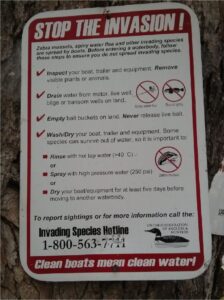 Invasive species are one of the greatest threats to the biodiversity of Ontario’s waters, wetlands and woodlands. Originating from other regions of the world, and in the absence of their natural predators or controls, invading species can have devastating effects on native species, habitats and ecosystems.
Invasive species are one of the greatest threats to the biodiversity of Ontario’s waters, wetlands and woodlands. Originating from other regions of the world, and in the absence of their natural predators or controls, invading species can have devastating effects on native species, habitats and ecosystems.
The Rideau Valley Conservation Authority (RVCA) does annual invasive species monitoring at Otty and other lakes in the Rideau and Tay watersheds.
Shown at right is a sign displayed at the public boat launch.
As of 2013, the RVCA had identified these invasive species at Otty Lake:
More recently these colonies have been discovered in our watershed:
One invasive species of concern that has not yet arrived at Otty is the Spiny Water Flea. Be on the lookout for quagga mussels, the hemlock
wooly adelgid, and the spotted lantern fly as well.
For a summary list of invasive species to watch for at Otty Lake, prepared spring 2015, click here.
Sources of Information
Ontarios Invasive Species Awareness Program
The Invading Species Awareness Program is a partnership of the Ontario Federation of Anglers and Hunters and the Ontario Ministry of Natural Resources and Forestry in order to address the increasing threats posed by invasive species in Ontario. See their website.
FOCA and Aquatic Invasive Species
The Federation of Ontario Cottagers Associations is concerned about the potential impacts of introduced species. FOCA supports member projects aimed at identification, education and outreach, eradication and preventing the spread of invasive species in Ontario. See their website.
Zebra Mussels
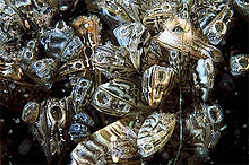 Zebra mussels were first discovered in 1988 in the Great Lakes and have since spread rapidly throughout fresh water lakes and canals in Canada and the Northern United States. They first appeared in Otty Lake in about 2002. Zebra mussels spread very quickly. Their eggs are transferred through bilges and bait wells that are not emptied and cleaned before being placed into a new water body. Opinions vary as to whether the zebra mussel population is on the decline in Otty Lake, but a research team is trying to find out.
Zebra mussels were first discovered in 1988 in the Great Lakes and have since spread rapidly throughout fresh water lakes and canals in Canada and the Northern United States. They first appeared in Otty Lake in about 2002. Zebra mussels spread very quickly. Their eggs are transferred through bilges and bait wells that are not emptied and cleaned before being placed into a new water body. Opinions vary as to whether the zebra mussel population is on the decline in Otty Lake, but a research team is trying to find out.
Click here to see a time series showing the spread of Zebra Mussels starting in 1986 (From USGS)
Problems Caused by Zebra Mussels
Killing native mussels
Introducing toxins to any waterfowl that feed on them
Clogging water pipes
Human hazard (they can cut and tear your skin)
Filtering algae from the water, thereby affecting other species
Increasing water clarity and light
By increasing the water clarity, zebra mussels cause the warmth of the sun to penetrate further in shallow areas. The nutrients they filter from the water are deposited as feces in shallow waters. One theory is that these conditions lead to increased abundance of aquatic plants and algal blooms, but it has not been proven.
Boaters who transport their boats between water bodies can help stop the spread of zebra mussels to lakes not already affected. Read more in the Shoreline Handbook page 51 and Zebra Mussels 101 by Derek Smith in February 2014 newsletter page 4.
Rusty Crayfish
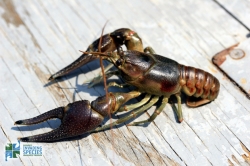
Rusty crayfish are large, freshwater crayfish, native to the Ohio Valley, that have now spread to the northeastern and midwestern United States, as well as Ontario where it was first seen in the early 1960s. The RVCA reports they have been found in Otty Lake. They likely were introduced to Ontario by anglers from other areas discarding crayfish they were using as bait.
Their aggressive eating habits lead them to consume large amounts of aquatic vegetation, causing the decline of native crayfish, and reducing the spawning and nursery habitat for native fish. Because the females can carry up 200 fertilized eggs under their tails, they can spread rapidly. See Ontario Invasive Species site for more.
Banded Mysterysnail
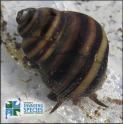
There are four types of snails that are considered invasive in Ontario. This particular snail is native to the United States. RVCA reports they have reached Otty Lake. They do well in lakes and slow moving rivers. They are a problem because they reproduce and spread rapidly, may prey on fish eggs and reduce survival rates, and out-compete for food and habitat and effect the abundance of native snails
Spiny Water Flea
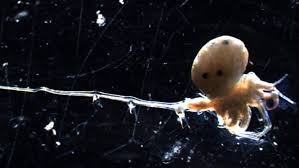 The spiny water flea is a predacious zooplankton that was transported from Europe to the Great Lakes in the ballast of ships in 1982. By 1987 it was in all of the Great Lakes, and is now in at least 80 Ontario Lakes, but not in Otty Lake. They are called spiny because their spines make up about 70% of their length. Spiny water fleas eat three times as much food as other zooplankton, so compete with native zooplankton and fish. Smaller fish that eat them cough them up because of the spiny water flea’s long spine. And they play a role in the biomagnification of contaminants such as mercury, which could affect top predatory fish like lake trout. They are also a nuisance as they build up on fishing lines.
The spiny water flea is a predacious zooplankton that was transported from Europe to the Great Lakes in the ballast of ships in 1982. By 1987 it was in all of the Great Lakes, and is now in at least 80 Ontario Lakes, but not in Otty Lake. They are called spiny because their spines make up about 70% of their length. Spiny water fleas eat three times as much food as other zooplankton, so compete with native zooplankton and fish. Smaller fish that eat them cough them up because of the spiny water flea’s long spine. And they play a role in the biomagnification of contaminants such as mercury, which could affect top predatory fish like lake trout. They are also a nuisance as they build up on fishing lines.
Eurasian Milfoil
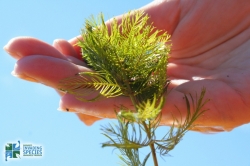 Eurasian water milfoil is a non-native, invasive water plant, first noted in Canada in 1961. It is much more aggressive than native water milfoil, reproducing mainly through the rooting of fragments of existing plants.
Eurasian water milfoil is a non-native, invasive water plant, first noted in Canada in 1961. It is much more aggressive than native water milfoil, reproducing mainly through the rooting of fragments of existing plants.
Milfoil grows in 1-6 metre water depths, forming dense surface mats. Milfoil will compete with native aquatic plants, and its density can result in poor spawning areas for fish. And we all know its effect on swimming and boating.
The exact year this aquatic plant appeared at Otty Lake is not known, although it was regarded as a major problem in the 2003-2007 timeframe. Since then the abundance of Eurasian Watermilfoil appears to have declined.
Most sources agree that milfoil cannot be eradicated, merely controlled, which implies that long-term follow-up is always required after removal. In particular, because milfoil spreads by rooting fragments of existing plants, it is essential when cutting any plants to capture the fragments and dispose of them ashore. If fragments escape, they will make the problem worse.
European Frogbit
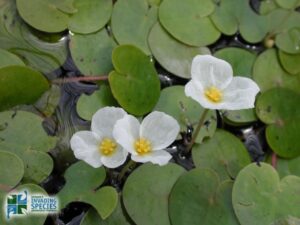 European frogbit is an invasive aquatic plant brought from Europe to Ottawa in 1932 as an ornamental plant. It has been at Otty Lake since at least 2009. The plant likes slow-moving water, where it forms dense, floating mats, crowding out native plants, and preventing sunlight from reaching submergent plants. It produces a small white flower with rounded petals and a yellow centre. It looks similar to several native plants, including white water lily. Reduce speed near infested areas, as boat wake can dislodge plants, and it can easily spread and reproduce from small fragments.
European frogbit is an invasive aquatic plant brought from Europe to Ottawa in 1932 as an ornamental plant. It has been at Otty Lake since at least 2009. The plant likes slow-moving water, where it forms dense, floating mats, crowding out native plants, and preventing sunlight from reaching submergent plants. It produces a small white flower with rounded petals and a yellow centre. It looks similar to several native plants, including white water lily. Reduce speed near infested areas, as boat wake can dislodge plants, and it can easily spread and reproduce from small fragments.
Phragmites
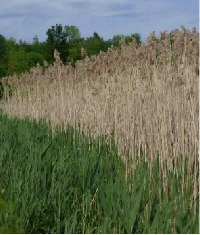 The non-native Phragmites australis (European Common Reed) is regarded as the most invasive plant in Canada, and is quickly becoming a problem in Lanark County. It grows well in wet areas and reproduces by seed or rhizome. It out-competes native plants altering habitats and affecting wildlife. Some examples of colonies are on the west side of the Rideau Ferry Road adjacent to the Jebbs Creek bridge and on the Perth Wildlife Road between the landfill site and the Otty Lake Side Road. It takes less than five years for phragmites to dominate an area, and is very difficult to eradicate. There is also a native version of phragmites, so it is important to learn to distinguish between the two. The OLA partnered on an educational webinar on the topic with the Friends of the Tay Watershed (FoTW) April 22, 2021. Thanks to the efforts of Linda Cuthbertson, the OLA has also received some funding from the Green Shovels Collaborative for some supplies to assist in phragmites eradication.
The non-native Phragmites australis (European Common Reed) is regarded as the most invasive plant in Canada, and is quickly becoming a problem in Lanark County. It grows well in wet areas and reproduces by seed or rhizome. It out-competes native plants altering habitats and affecting wildlife. Some examples of colonies are on the west side of the Rideau Ferry Road adjacent to the Jebbs Creek bridge and on the Perth Wildlife Road between the landfill site and the Otty Lake Side Road. It takes less than five years for phragmites to dominate an area, and is very difficult to eradicate. There is also a native version of phragmites, so it is important to learn to distinguish between the two. The OLA partnered on an educational webinar on the topic with the Friends of the Tay Watershed (FoTW) April 22, 2021. Thanks to the efforts of Linda Cuthbertson, the OLA has also received some funding from the Green Shovels Collaborative for some supplies to assist in phragmites eradication.
Here are some additional resources:
Inside Ottawa Valley story by Ashley Kulp: ‘Phragmites wakes people up’: Fast spreading invasive plant species storms Lanark County
CBC story by Robin Miller: ‘Murder of the wetlands’: Invasive phragmites spreading to Lanark County
Lanark County brochure: Phragmites: Best Management Practices
A story by Murray and Karen Hunt in the June 2018 edition of Captain Otty’s Log
CFRA interview of David Overholt April 25: listen to MP3
<back to top>
Reporting Invasive Species
EDD MapS Ontario
Track invasive species online or with your mobile device. Sign up at www.EDDMapS.org/Ontario, a web-based mapping of invasive species distribution. Contact OFAH/OMNR Invading Species Awareness Program at 1-800-563-7711 or email [email protected].

Invasive Species Hotline
Think you’ve found an invasive species or want more information on invasive species? Contact the Invading Species Hotline 1-800-563-7711.